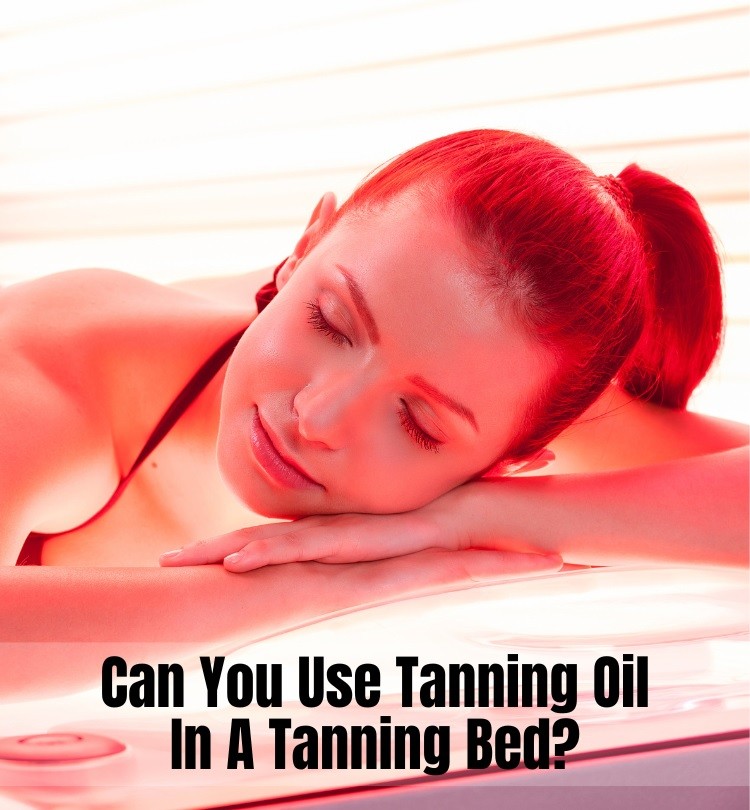This post contains affiliate links.
Updated on February 24, 2025
Yes, you can use tanning oil in a tanning bed. Tanning oils help to increase the absorption of UV rays and enhance the tanning process.
It is important to choose a tanning oil specifically designed for indoor tanning, as outdoor tanning oils may not be suitable for indoor use. It is also recommended to choose an oil with a lower SPF, as too high of an SPF can block the UV rays and hinder the tanning process.
When using tanning oil in a tanning bed, make sure to follow the instructions provided by the bed manufacturer and do not overexpose your skin to UV rays. With proper use, tanning oil can help to achieve a deeper and longer-lasting tan.
Contents
Why Tanning Oil Is Popular

Tanning oil has been a popular choice for sunbathers and indoor tanning enthusiasts for many years. In recent times, tanning oil has gained more popularity specifically for use in tanning beds. Many people wonder if tanning oil works in tanning beds and if it is safe to use.
In this post, we will answer those questions and share some insights into the popular choice of tanning oil.
Related: Does Olive Oil Help You Tan?
Benefits Of Using Tanning Oil
Using tanning oil can provide you with various benefits. Here are some of the key benefits of using tanning oil:
- Moisturizes your skin: Tanning oils are specially formulated to moisturize your skin while you are tanning, preventing dryness and flakiness that can occur after sun exposure.
- Enhances tanning results: Tanning oil helps to intensify your tanning results by reflecting UV rays emitted by the tanning bed back onto your skin.
- Feels luxurious: Many tanning oils have a luxurious texture that feels great on your skin, giving you a pampered feel while you tan.
How Tanning Oil Works On Your Skin?
Tanning oils work by increasing the effectiveness of UV rays on your skin. Tanning oils contain ingredients that cause the melanin in your skin to darken, enhancing your skin’s natural tanning process. The oils also reflect the UV light, helping to deepen the color of your tan.
Using tanning oil can help you get a deeper, darker, and longer-lasting tan in less time. It’s important to note that using tanning oil does not provide any protection against UV rays. Therefore, it is crucial to follow all tanning bed safety precautions, including using sunscreen with a high SPF before and after tanning.
Using tanning oil in a tanning bed can be a great way to enhance your tanning results. It is essential to follow all safety precautions and only use tanning oil designed specifically for indoor tanning. Hopefully, this post has helped you understand why tanning oil is so popular and how it can benefit your tanning routine.
Tanning Beds: How They Work And Their Impact On Skin
Tanning beds are a popular alternative to traditional sunbathing but, like any form of tanning, it comes with potential risks. Tanning beds work by emitting UV rays, which stimulate the melanin in your skin, giving it a darker appearance. But how exactly do tanning beds work, and what impact can they have on your skin?
The Science Behind Tanning Beds
Tanning beds utilize uva and uvb rays to stimulate melanin, the pigment that gives our skin its color. Uva rays penetrate deeper into the skin, while UVB rays cause more superficial damage. The bulbs in tanning beds emit much stronger uv rays than the sun, which can lead to quicker tanning, but also an increased risk of skin damage.
Potential Risks Of Tanning Beds
While tanning beds can be a convenient way to achieve a sun-kissed glow, it’s important to understand the potential risks associated with their use. Here are some potential risks to consider:
- Skin damage: Prolonged exposure to UV radiation can prematurely age the skin, leading to wrinkles, fine lines, and age spots.
- Skin cancer: Research has shown a link between tanning bed use and an increased risk of skin cancer, including deadly melanoma.
- Eye damage: Tanning beds can emit harmful UV radiation that can cause damage to the eyes, including cataracts, macular degeneration, and even blindness.
To minimize the risk of negative side effects, it’s important to practice safe tanning habits when using tanning beds. This includes wearing protective eyewear and applying spf sunscreen to the skin to help prevent sunburn and skin damage. It’s important to remember that while tanning can provide a temporary sense of confidence, the long-term risks outweigh the benefits.
Related: How Long Do Tanning Lotions Last?
Types Of Tanning Oils

Getting that perfect tan is every beach-goer’s dream. For those living in colder regions or those who want a quick tan, a tanning bed seems like the best option. But can you use tanning oil in a tanning bed?
Tanning oils work by amplifying the UV rays, allowing your skin to get that perfect glow. This section will explore the different types of tanning oils that you can use for your tanning bed session.
Accelerators Vs. Maximizers
- Accelerators: These tanning oils contain ingredients like tyrosine and copper, which help in building up melanin in your skin, giving you a natural, even tan.
- Maximizers: These tanning oils contain ingredients that stimulate blood flow in your skin, resulting in a darker tan. Maximizers are ideal for people with already-tanned skin, as it helps enhance the existing tan.
Oil Vs. Lotion Tanning Products
Choosing between oil and lotion tanning products depends on your skin type, tanning goals and personal preference. Here are the key differences between the two:
- Oils: Tanning oils are ideal for people with dry skin as it helps in moisturizing your skin, resulting in a healthier-looking tan. Oil tanning products also work faster than lotions due to their thinner consistency.
- Lotions: Tanning lotions contain ingredients like aloe vera and coconut oil, which help in soothing your skin during and after the tanning process. Lotions also work better for people with sensitive skin as it absorbs slower than oil, giving more time for your skin to adjust to the tanning process.
Tanning oils can be used in a tanning bed for a healthier-looking and natural tan. When choosing a tanning product, it’s essential to consider your skin type, tanning goals and personal preference, and always remember to apply sunscreen before and after using a tanning bed.
With the right tanning oil and proper skin care, you’ll be able to achieve that perfect tan in no time.
Using Tanning Oil In A Tanning Bed: What You Need To Know?
If you’re someone who loves to get a beautiful even tan, using tanning oil in a tanning bed might seem like a great idea. There are certain things you need to know before you go ahead with it. We’ll be discussing the do’s and don’ts, along with the correct application process you need to follow to ensure a safe and effective tan.
Do’s And Don’ts Of Using Tanning Oil In A Tanning Bed
Do’s:
- Choose the right tanning oil that is specifically designed for indoor tanning beds.
- Keep your skin moisturized by applying a daily lotion to lock in hydration.
- Rotate your body every few minutes in the tanning bed to get an even tan.
- Use protective eye goggles to protect your eyes from harmful ultraviolet rays.
- Wear minimal clothing, like a bikini or shorts, to cover your private parts only.
Don’ts:
- Don’t use outdoor tanning oils, as they can cause skin damage and might not help in achieving the desired results in a tanning bed.
- Don’t overdo it by using excessive amounts of tanning oil, as it can lead to severe burns, rashes and skin peeling.
- Avoid using tanning oils that contain acetone, mineral oils and alcohol, as they can dry out your skin and hamper the tanning process.
- Don’t remove your eye protection during the tanning bed session, even for a minute, as it can lead to temporary or permanent vision loss.
How To Apply Tanning Oil Correctly For A Safe And Effective Tan?
Follow these simple steps to guarantee a safe and effective tanning session using oil:
- First, apply sunscreen lotion to the fragile parts of your body including the eyes, lips, and areola to prevent the risk of burns.
- After spraying or applying tanning oil to your body in the tanning bed, before lying down, take a cloth or towel and gently blot the oil on your skin. This helps to remove any excess oil and gives you an even-toned shade.
- Keep a watch on the time. Most experts suggest not to stay in the tanning bed for more than 20 minutes irrespective of the skin type.
- After finishing your session, wipe off the oil from your skin and take a shower with a moisturizing soap. It helps keep your skin smooth and hydrated.
With the right tanning oil and applying it correctly, you can achieve an even, golden tan while minimizing the risk of burns and other hazards. Keep in mind the do’s and don’ts and always prioritize safety to enjoy the perfect tan without any worries.
Related: How To Use Contour Kit?
Alternatives To Tanning Beds And Tanning Oil

We’ll discuss the benefits of self-tanning products and spray tans as alternative options to using a tanning bed and tanning oil.
Self-Tanning Products: Pros And Cons
Self-tanning products are an excellent option for those who want a tan without exposure to harmful UV rays. Here are some pros and cons of self-tanning products:
Pros
- Safe and easy to use
- Available in various forms, including lotions, sprays, and mousse
- Can be used on the face and body
- Offers a natural-looking tan without damaging the skin
- Can be reapplied as often as needed to maintain the desired color
Cons
- May leave uneven color if not applied correctly
- Can be difficult to remove if you make a mistake
- May not last as long as a natural tan
- Some products have a strong scent that may not be pleasant to everyone
At-Home Vs. Professional Spray Tanning: Which One Is Right For You?
Spray tanning is becoming an increasingly popular alternative to using a tanning bed. Here are some things to consider when deciding whether to go for an at-home spray tan or visit a professional:
At-Home
- Convenient and cost-effective
- Available in various forms, including sprays and lotions
- Can be done in the privacy of your own home
- May require some practice to achieve the perfect tan
Professional
- Professional results guaranteed
- Typically lasts longer than at-home options
- Can be customized to your skin tone
- Offers even color and no missed spots
Tanning beds and tanning oils can be harmful to your skin if not used correctly. Instead, consider using self-tanning products or spray tanning as a safe and convenient way to achieve a bronzed glow. Make sure to practice proper application techniques to achieve the best results, and always prioritize the health of your skin.
Frequently Asked Questions
Is It Safe To Use Tanning Oil In A Tanning Bed?
Yes, but make sure to choose oil specifically designed for indoor tanning to avoid potential skin damage.
Can Tanning Oil Increase The Effectiveness Of Tanning Beds?
Yes. Tanning oils have light-reflecting ingredients that help boost uv ray absorption, but use them in moderation.
Can Tanning Oil Help Me Achieve A Darker Tan In A Shorter Time?
Yes, but be cautious. Using too much tanning oil can damage your skin and is not a substitute for safe tanning practices.
Do I Need To Remove Tanning Oil Before Getting Into A Tanning Bed?
Yes, it is recommended to remove any oils, lotions, or perfumes to ensure even coverage and avoid clogging the tanning bed’s filters.
Can I Use Any Type Of Oil In A Tanning Bed?
No. You should always use tanning oil specifically formulated for indoor tanning to avoid skin damage and potential equipment failures.
Conclusion
After diving into the question of whether tanning oil can be used in a tanning bed, we’ve come to a clear conclusion. While tanning oils can provide a deep, glowing tan under the sun, it’s not recommended to use them in a tanning bed due to the potential risks involved.
Tanning beds have their own set of hazards, and adding tanning oils could increase the chances of skin damage and health problems. To achieve a beautiful tan while tanning indoors, there are numerous tanning lotions and creams available that are specially formulated for indoor use.
So, before exposing your skin to harmful rays, always take time to read instructions and labels and select an ideal tanning solution for indoor tanning. Let’s prioritize health and safety while getting our ideal tan look!

